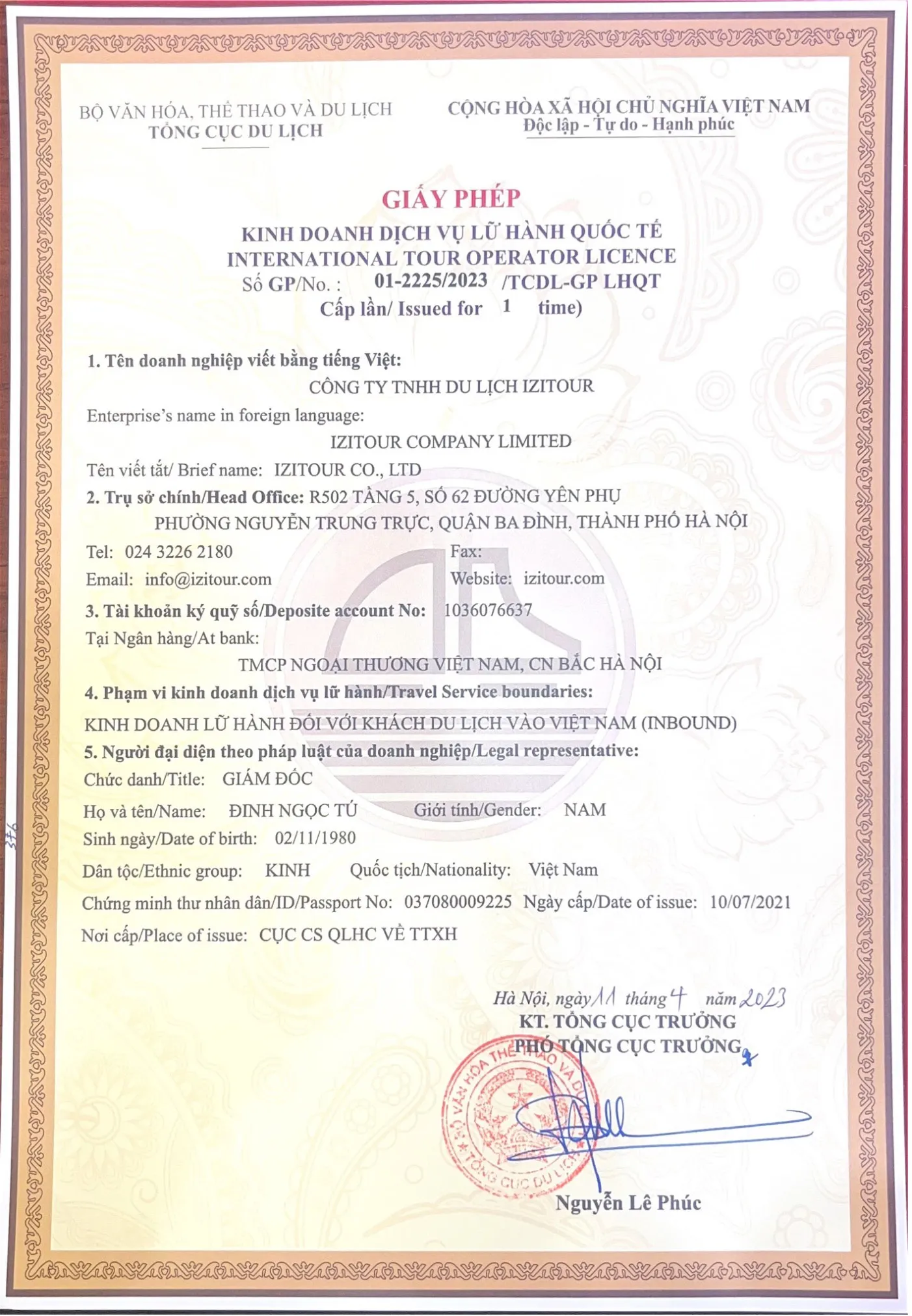Quy Nhon, a hidden gem on Vietnam’s south-central coast, is quickly gaining attention as one of the country’s most beautiful yet underrated destinations. Unlike the bustling cities or overcrowded beaches elsewhere, Quy Nhon offers travelers a perfect blend of pristine coastline, charming fishing villages, fresh seafood, and authentic local culture.
If you are wondering “what to do in Quy Nhon” or looking for a complete guide to the best activities, this article will walk you through everything from relaxing on quiet beaches and exploring nearby islands to tasting local specialties and enjoying vibrant nightlife. Whether you are a first-time visitor or returning to discover more, Quy Nhon has plenty of experiences waiting for you.
- 1. Introduction to Quy Nhon
- 2. What to do in Quy Nhon for first-time visitors
- 2.1. Relaxing on Ky Co and Quy Hoa beaches
- 2.2. Exploring Eo Gio and other coastal cliffs
- 2.3. Visiting Cham towers and ancient temples
- 2.4. Snorkeling and diving around Hon Kho Island
- 2.5. Wandering through local fishing villages
- 2.6. Hiking to Vung Chua Mountain for panoramic views
- 2.7. Discovering hidden gems like Ghenh Rang and Queen’s Beach
- 2.8. Enjoying fresh seafood by the sea
- 2.9. Tasting Quy Nhon specialties
- 2.10. Experiencing the vibrant Quy Nhon night market
- 3. Travel tips for visiting Quy Nhon Vietnam
1. Introduction to Quy Nhon
Quy Nhon, a coastal city in south-central Vietnam, lies roughly halfway between Nha Trang and Da Nang, making it an appealing destination that is included in select travel itineraries rather than a standard stop on every Vietnam tour. Travelers who do choose to come here are often rewarded with a quieter, more authentic experience away from the usual crowds.
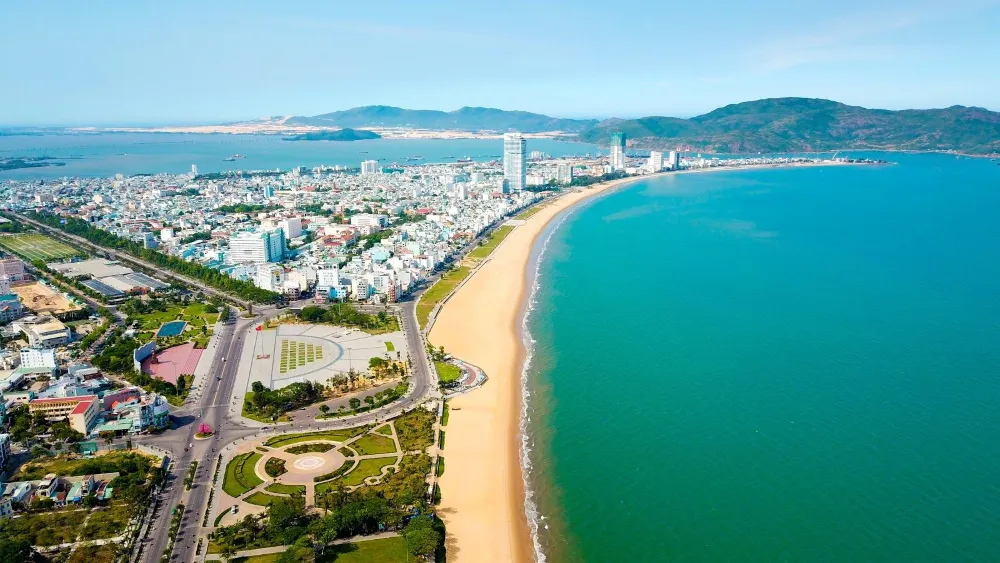
The city boasts more than 70 kilometers of stunning coastline, lined with golden sand beaches, hidden coves, and traditional fishing villages. Compared to the busier coastal hubs like Da Nang or Nha Trang, Quy Nhon feels calmer and more laid-back, making it ideal for travelers seeking a slower pace.
Famous for its Cham towers, fresh seafood, and scenic landscapes, Quy Nhon also serves as the capital of Binh Dinh Province (now Gia Lai Province), an area with deep historical and cultural significance. One of its standout features today is the connection to The Vietage by Anantara, a luxury railway carriage linking Quy Nhon with Da Nang and Hoi An. This exclusive train journey has helped put Quy Nhon on the map for travelers seeking premium experiences, combining scenic landscapes with five-star service.
Historically, Binh Dinh was once an important center of the ancient Champa Kingdom. In the 19th and early 20th centuries, Quy Nhon also became a point of contact with Western missionaries and traders, adding layers of cultural interaction that still intrigue international visitors today.
Quy Nhon's weather is generally warm and sunny for much of the year, suitable for beach activities and outdoor exploration. Beyond its natural beauty, Quy Nhon is also known for its friendly locals, slower pace of life, and vibrant culture.
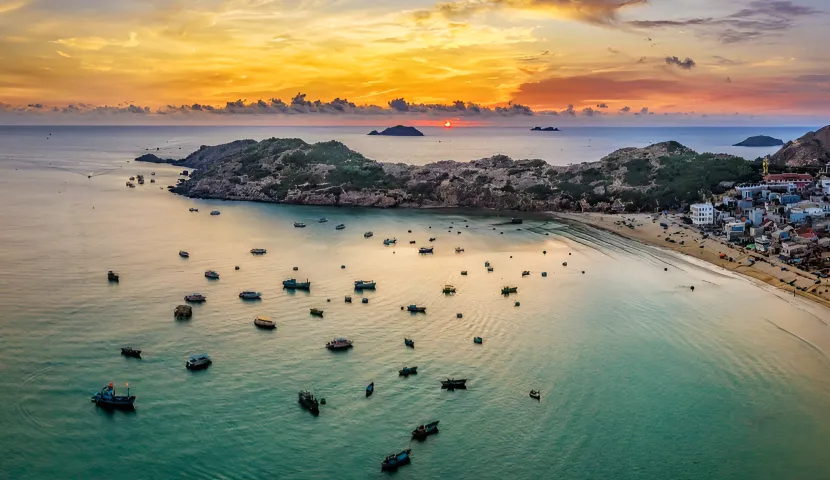
With its mix of landscapes, heritage, and unique experiences like the luxury train, Quy Nhon is steadily emerging as one of Vietnam’s most rewarding off-the-beaten-path destinations.
Vietnam Luxury Tour through Culture & Comfort
2. What to do in Quy Nhon for first-time visitors
2.1. Relaxing on Ky Co and Quy Hoa beaches
Ky Co Beach is one of Quy Nhon’s most beautiful coastal spots, renowned for its dynamic, resort-like atmosphere. The striking visual appeal comes from its emerald-turquoise water, which is exceptionally clear and perfect for swimming within the naturally sheltered bay and the dramatic pairing of golden, fine sand with steep, rocky cliffs. Visitors primarily enjoy sunbathing and swimming in the calm, refreshing waters. The surrounding rocks and cliffs create a spectacular visual frame, making it a highly photogenic spot. For those seeking a thrill on the water, the beach provides various water sports services, including kayaking and jet-skiing, ensuring a lively and engaging day out.
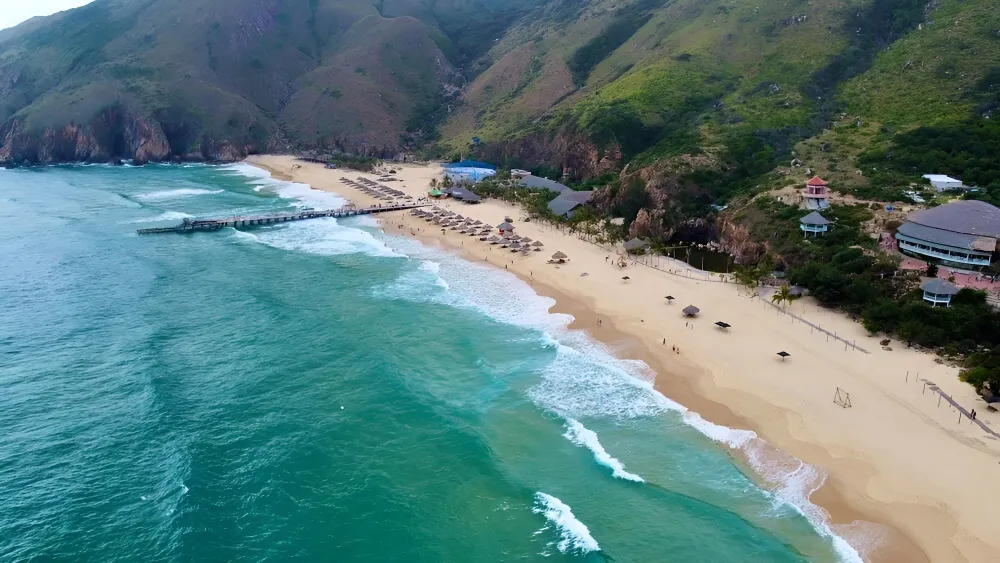
In contrast, Quy Hoa Beach offers a distinctly tranquil and contemplative escape. The gently curving sandy beach is bordered by refreshing casuarina trees, creating a serene, almost romantic setting ideal for quiet contemplation. This is the place for a leisurely walk, meditation, or simply escaping into a good book while the rhythmic sounds of the waves provide the soundtrack. What distinguishes Quy Hoa is its cultural connection. The beach lies adjacent to the Quy Hoa Leprosy Treatment Facility, a historic site where the celebrated Vietnamese Poet Han Mac Tu lived and worked. The small, charming, and often classical-style architecture sprinkled throughout the area also adds a unique, artistic flavor.
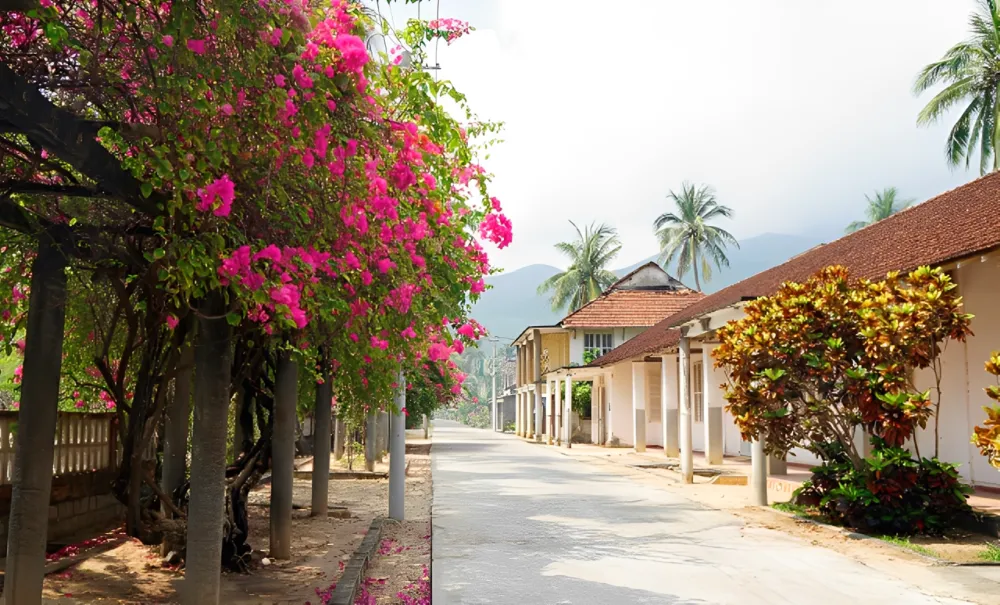
Visiting these both Quy Nhon’s beaches gives travelers a chance to enjoy the city’s natural beauty in two very different moods which are lively and serene. To fully capture the beauty and enjoy the activities, planning your visit during the dry season (March to September) is essential. This period offers the most favorable conditions: minimal rain, abundant sunshine, and most crucially, a calm sea with optimal water clarity. These are the perfect months for swimming and smooth boat travel to Ky Co. While the peak season from June to August boasts the absolute best weather, it is also the most crowded time. It is advised to avoid the rainy season (typically October to February).
>> See more in our Quy Nhon Beaches Guide
2.2. Exploring Eo Gio and other coastal cliffs
Eo Gio, literally meaning “Wind Strait”, is defined by dramatic rock formations and winding paths along the cliffs, where the coastline curves sharply into the sea. The main attraction here is not swimming as the rough waters and rocky terrain make it unsuitable for typical beach activities, but rather the unique experience of panoramic views, invigorating sea breezes, and the sheer, rugged power of the ocean. Visitors are invited to explore the area via meticulously constructed, winding stone paths built right along the cliffs.
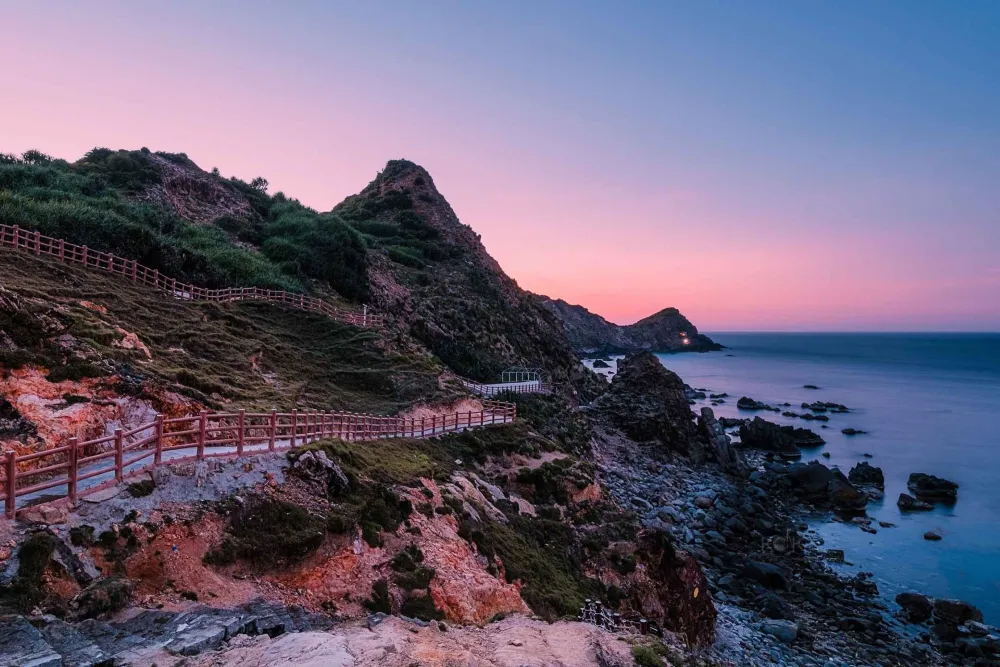
Sunset over Eo Gio, Quy Nhon
As you walk, you are surrounded by the immersive sounds of nature. The distinct whistle of the wind carves its way through the strait and the powerful, rhythmic crashing of waves against the multi-hued rocks below. These breathtaking scenes, especially when illuminated by the glow of a spectacular sunset, make Eo Gio an absolute favorite spot for photographers and dedicated nature lovers seeking to capture the coastline’s untamed essence. This is truly a place for appreciating the raw geological artistry of Vietnam's central coast.
See more: Top 17 Unmissable Attractions in Quy Nhon
2.3. Visiting Cham towers and ancient temples
Quy Nhon and the wider Binh Dinh area are home to several Cham towers dating back centuries, serving as a vital center of the ancient Champa Kingdom. Two of the most accessible and celebrated sites are the Twin Towers (Thap Doi), located right within Quy Nhon city, and the majestic Banh It Towers, found slightly further inland.
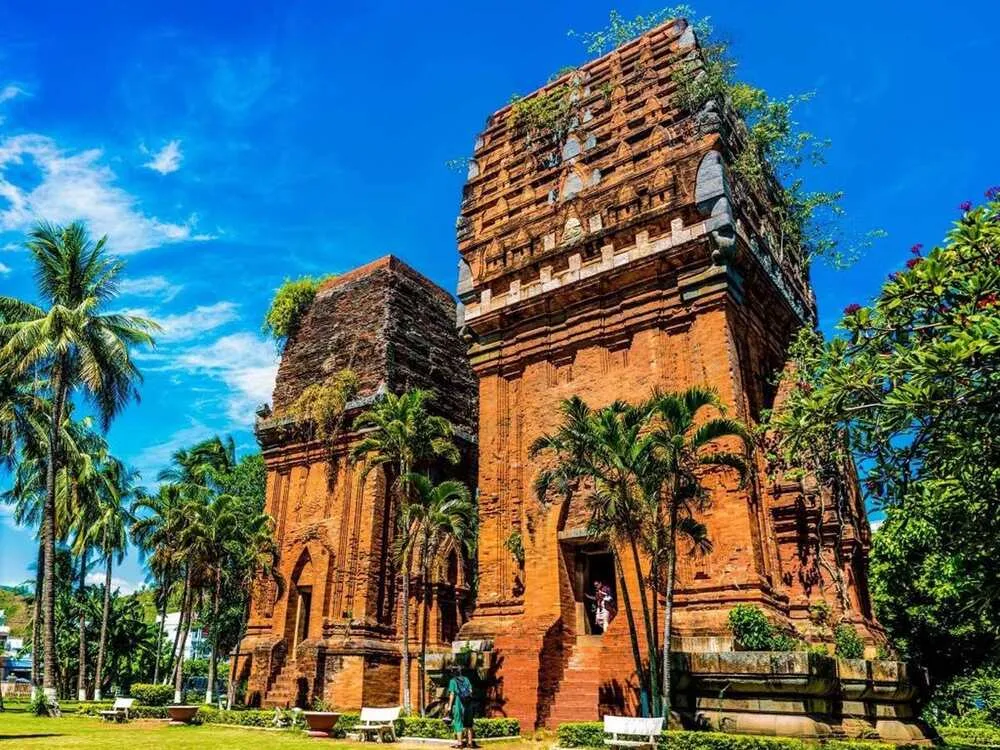
Ancient Twin Towers in Quy Nhon, showcasing unique Champa culture and history
- Twin Towers (Thap Doi): Uniquely featuring two side-by-side towers, this site showcases the distinctive architectural fusion that emerged during the late Champa period, blending local traditions with Khmer influences. The towers are surprisingly accessible, sitting close to urban life, yet offering a peaceful moment of contemplation.
- Banh It Cham Temple (Thap Banh It): Often cited as one of the best-preserved clusters of Cham towers, this group is picturesquely situated on a hilltop, providing sweeping panoramic views of the surrounding countryside. Its name, "Banh It", comes from the resemblance of the main tower's shape to a local pyramid-shaped glutinous rice cake. The site is remarkable for its diverse architecture, featuring several smaller auxiliary towers alongside the main structure, demonstrating a complex religious and defensive layout.
These structures, built with red bricks and intricate carvings, reflect the spiritual and architectural legacy of the ancient Champa Kingdom. Exploring these sites not only offers a glimpse into Vietnam’s pre-modern history but also provides a quiet, reflective atmosphere away from the beach crowds.
2.4. Snorkeling and diving around Hon Kho Island
The coastal waters off Quy Nhon are teeming with life, offering several exceptional locations for underwater exploration, perfect for coral reef exploration. Just a short boat or canoe ride from the mainland, these areas promise stunning visibility and vibrant marine ecosystems.
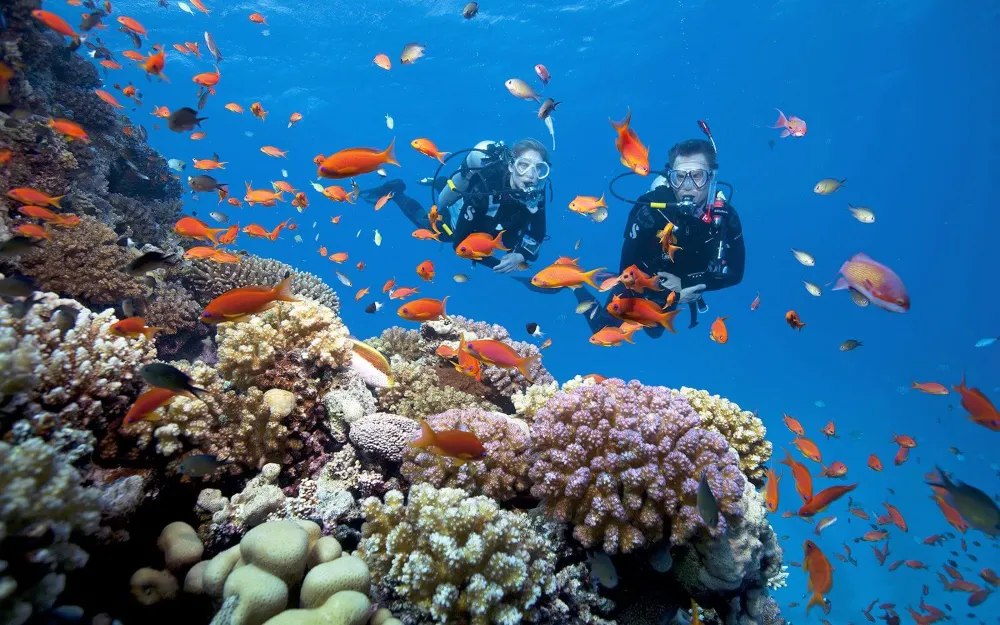
Snorkeling or diving in the clear waters around a beautiful Quy Nhon island
- Hon Kho Island (Dry Island) is regarded as a paradise for underwater explorers. Its shallow, crystal-clear waters and gentle currents make it an ideal spot for snorkeling and beginner diving. The reefs here are home to vibrant coral gardens and mesmerizing schools of colorful fish. The island itself is simple and rustic, with wooden bridges stretching over the sea and fresh seafood served right by the shore. Visitors can also enjoy the freshest local seafood served right by the shore after their dive, making Hon Kho a holistic experience of nature and local flavor.
- To the north of Quy Nhon, near the Nhon Ly peninsula, lie two more captivating spots for coral viewing. One of them is Hon Seo (Rock Island). Distinguished by its dramatic rock formations, this spot offers a more rugged diving environment. The currents around Hon Seo often bring clearer water, revealing diverse and expansive coral reefs thriving beneath the surface. Due to its deeper drop-offs in some areas, Hon Seo is particularly appealing for those seeking a more adventurous snorkeling or diving experience.
- Bai Dua (Pineapple Beach) is often included in tours from Nhon Ly. Bai Dua is famous for its Staghorn coral và Acropora coral. Its relatively shallow waters are easily accessible and safe for beginner snorkelers, providing a great chance to witness Quy Nhon’s natural coral reef ecosystem.
2.5. Wandering through local fishing villages
Villages like Nhon Hai and Nhon Ly provide an intimate and unfiltered look into the daily rhythm of life for Quy Nhon's fishing communities. As you wander the sandy lanes and narrow alleys, you're immediately immersed in the vibrant, authentic atmosphere. The view is dominated by an array of blue boats, especially the distinctive thung chai (coracle boat), bobbing in the clear bay waters, and expansive fishing nets drying in the sun. You'll witness locals meticulously preparing their gear for the next journey out to sea or returning with the fresh catch of the day, offering a lively, hands-on demonstration of their centuries-old trade.
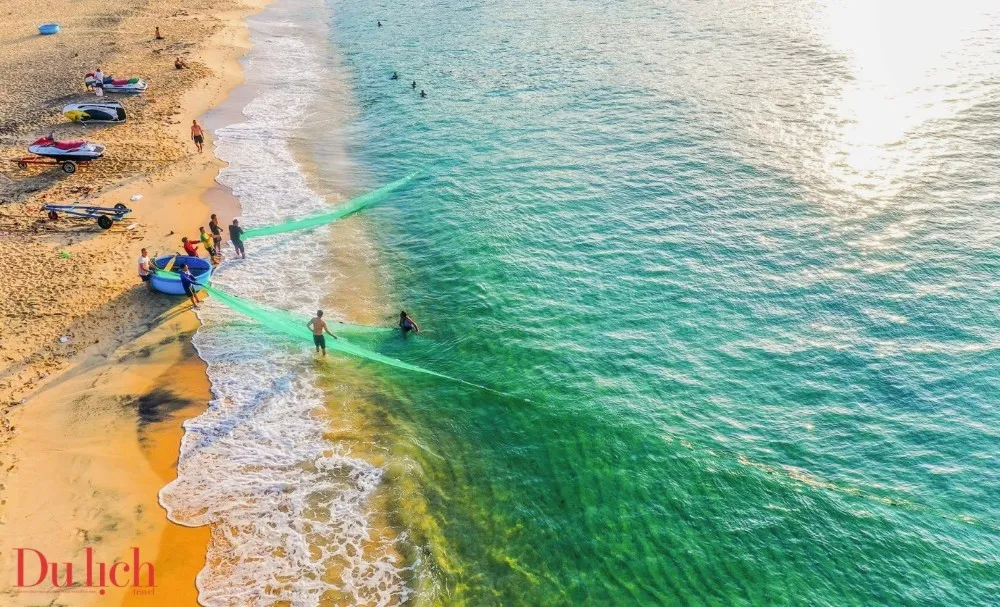
The true richness of this experience lies in the warm hospitality of the villagers. Many homestays in these villages offer more than just an overnight stay; they provide a chance for genuine cultural exchange. Guests have the option to wake up early and join the fishermen for activities like pulling in nets or casting lines, truly understanding the labor behind the regional seafood. Alternatively, you can simply share meals with local families, tasting fresh, home-cooked dishes and hearing stories of the sea. This interaction highlights the cultural richness of the region.
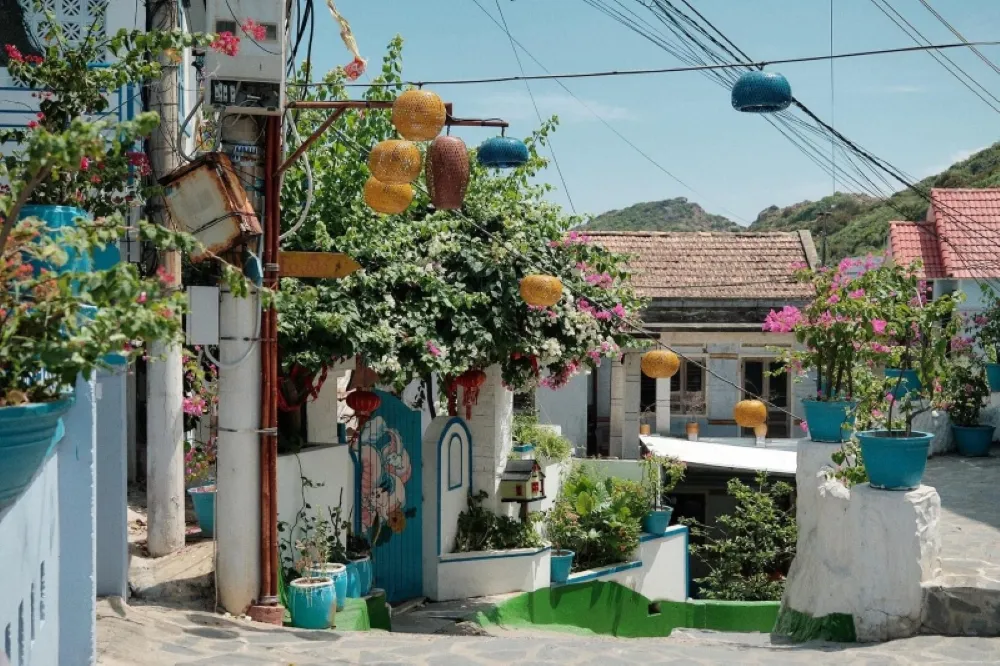
2.6. Hiking to Vung Chua Mountain for panoramic views
For a different perspective of Quy Nhon, head to Vung Chua Mountain. The hike is relatively easy and rewards travelers with sweeping views of the city, the coastline and the surrounding hills. At the top, you’ll also find a peaceful pagoda where locals come to pray. This activity combines light adventure with cultural discovery, making it suitable for travelers of all ages.
2.7. Discovering hidden gems like Ghenh Rang and Queen’s Beach
Ghenh Rang is a scenic area situated just south of Quy Nhon, renowned for its harmonious blend of natural rock formations and secluded coves. This area exudes a romantic beauty, contrasting sharply with the city's main beaches while remaining conveniently close to the urban center.
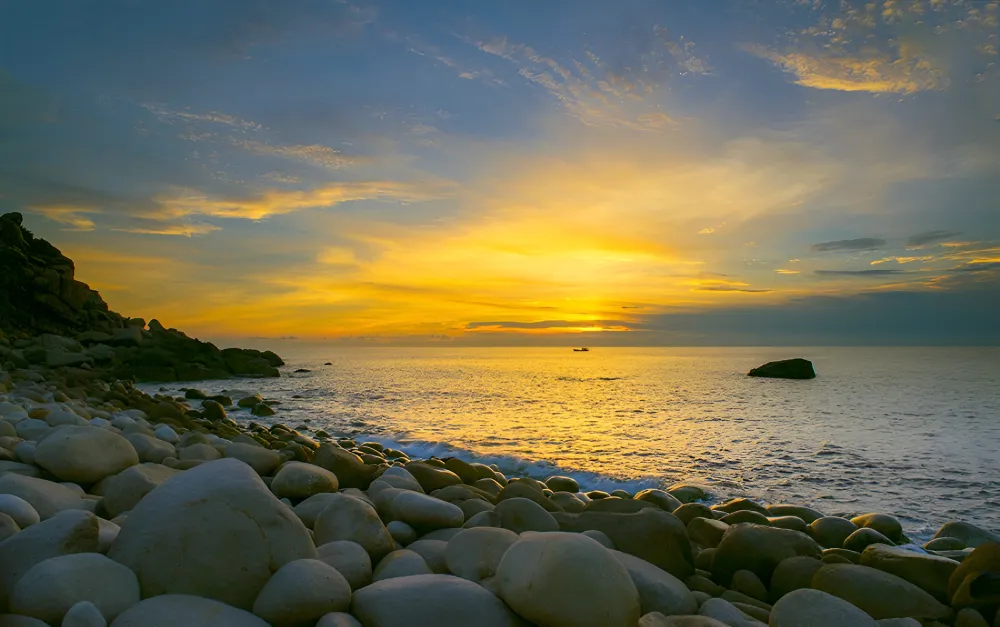
Scenic rocks and coastal views at Ghenh Rang Tien Sa, a must-visit natural site near Quy Nhon.
Within this area lies Queen's Beach (Bai Hoang Hau). The beach was named after Empress Nam Phuong, Vietnam’s last queen, who is said to have chosen this serene spot as her private retreat due to its tranquility and unique beauty. The distinctive feature of this shoreline is the millions of smooth, oval-shaped stones, polished by the waves and resembling giant eggs, scattered across the beach. The uniqueness of these stones creates an incredibly photogenic and distinct setting, completely free of traditional sand. When the waves roll in, the stones shift and gently clatter, producing a characteristic, soothing sound. The Ghenh Rang area also features paths that lead up the hillsides, allowing visitors to take in sweeping panoramic views of the entire Quy Nhon and its beautiful, curving coastline from an elevated vantage point. This area offers a quiet and more private atmosphere, making it ideal for peaceful strolls, relaxation and soaking up the fresh air.
2.8. Enjoying fresh seafood by the sea
Seafood in Quy Nhon is both abundant and affordable, thanks to the city’s thriving fishing communities. Freshness is the key ingredient, and the flavor of Quy Nhon's seafood is unparalleled. The popular dishes are incredibly varied, ranging from fragrant grilled scallops topped with peanuts and spring onions, to steamed snail dishes with lemongrass, and steaming seafood hotpots packed with fresh squid and prawns. Each dish is typically prepared simply to fully retain the natural sweetness of the sea.
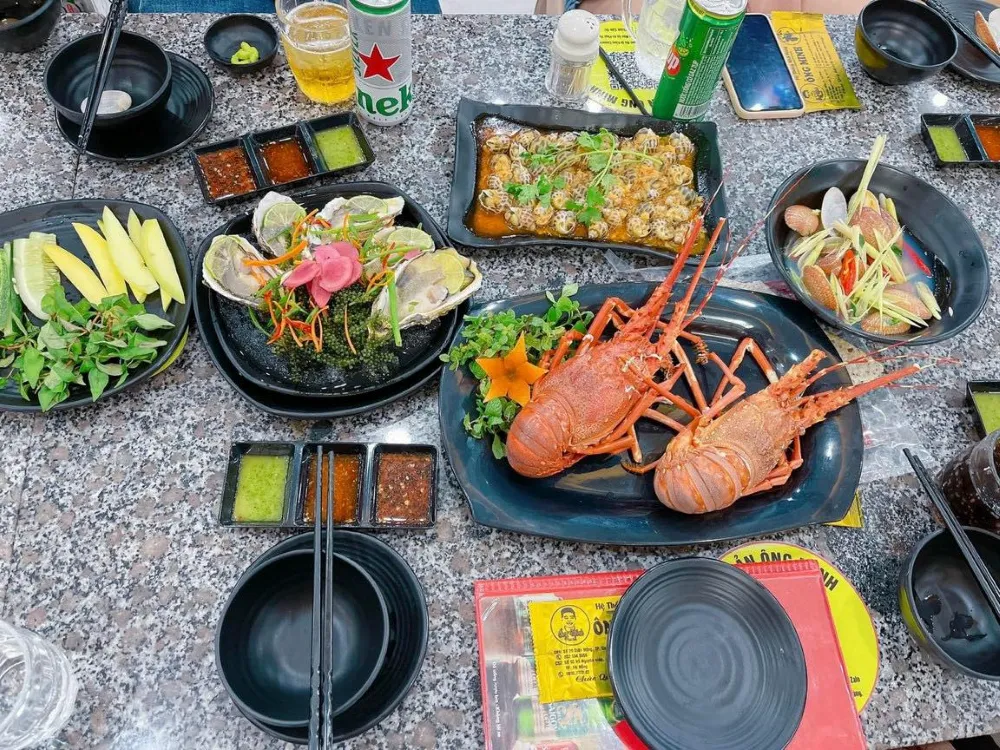
What makes this a truly authentic coastal dining experience is the service method. At many beachfront restaurants and popular food night markets, you get to personally select your live seafood directly from the tanks. Whether it's crab, mantis shrimp, lobster, or various kinds of fish and snails, you can inspect the freshness and tell the chef to prepare it exactly to your liking, be it steamed, grilled, stir-fried with tamarind sauce, or cooked into a savory porridge. This interactive experience is as much a part of the local culture as it is a meal.
2.9. Tasting Quy Nhon specialties
Food is at the heart of any Quy Nhon experience. Sampling the local dishes here not only satisfies your appetite but also introduces you to the region’s distinctive culinary traditions. The two most famous and beloved dishes that you absolutely shouldn't miss are Banh Xeo Tom Nhay (Sizzling shrimp pancakes) and Bun Cha Ca (Fish cake noodle soup).
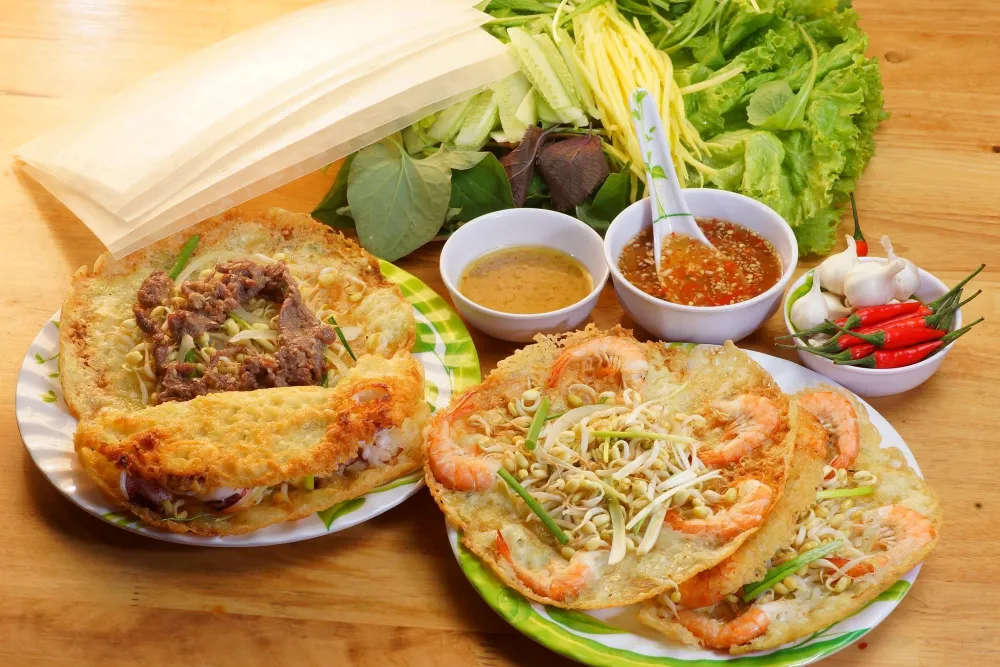
Crispy sizzling pancake with shrimp - a famous Quy Nhon specialty street food
Banh Xeo Tom Nhay is a dish found across Vietnam, but the version here is unique. "Tom Nhay" literally means "jumping shrimp", referring to the absolute freshness of the tiny shrimp used. The pancakes are cooked in small molds, achieving a perfect, paper-thin crispiness, and are filled with those sweet fresh shrimp and bean sprouts. The traditional way to eat it is to wrap the pancake with an assortment of fresh herbs (such as lettuce, mint, shredded green mango) inside a thin rice paper. The soul of the dish is the dipping sauce which balances savory, spicy, sweet, and sour flavors, often featuring ground peanuts, adding a rich depth.
Bun Cha Ca is an ideal dish for breakfast or a light meal. The broth is famous for being simultaneously light and exceptionally flavorful, simmered from fish bones and heads, giving it a natural, oceanic sweetness. The main attraction is the skillfully prepared fish cakes, available in both fried and steamed varieties, which have a characteristic springy texture and natural sweetness. The soup is typically seasoned with a local chili paste and a squeeze of lime, creating a perfect piping hot bowl.
Both dishes are best enjoyed at unassuming roadside eateries or small, local shops. These are the places where age-old family recipes are preserved, ensuring the flavors are always authentic, providing a true taste of local street food culture.
>> See more in our Quy Nhon Food Guide
2.10. Experiencing the vibrant Quy Nhon night market
As evening falls, Quy Nhon’s night market comes alive with food stalls, souvenir shops, and street performers. Here, you can try local snacks, shop for handmade crafts, and soak in the lively atmosphere with both locals and fellow travelers. It’s also a great spot to wind down the day with a sweet dessert or a refreshing drink while people-watching. The market showcases the youthful energy of the city and offers a fun contrast to its tranquil beaches.
The night market brings together street food, souvenirs, and local life. Strolling through, you can sample snacks, shop for small handmade items, or simply enjoy the lively evening atmosphere alongside both residents and fellow travelers.
3. Travel tips for visiting Quy Nhon Vietnam
3.1. How to get to Quy Nhon?
Quy Nhon is accessible by plane, train, or bus. Phu Cat Airport (UIH) is about 30 km from the city center and has daily flights from Hanoi, Ho Chi Minh City, and Da Nang. If you prefer traveling by rail, Dieu Tri Station, 10 km outside the city, connects Quy Nhon to the North–South railway, with both standard trains and the luxury Vietage by Anantara option. Long-distance buses also run from nearby destinations like Nha Trang, Da Nang, or the Central Highlands.
3.2. Best time to visit Quy Nhon
Quy Nhon enjoys warm weather most of the year, with average temperatures ranging between 24°C and 32°C (75°F – 90°F). The dry season, from January to August, is ideal for beach activities and outdoor adventures. The rainy season usually lasts from September to December, when occasional storms or rough seas may affect travel plans.
3.3. Culture and safety notes
This region is generally safe and welcoming to travelers. Even solo female travelers can travel Quy Nhon with assurance. About custom, as in other parts of Vietnam, travelers should show respect at religious sites by dressing modestly and behaving quietly is appreciated. Bargaining in local markets is common, but it’s best done with a smile. Be cautious when swimming at remote beaches, as currents can be strong and lifeguards are not always present. It’s best to only swim in the allowed beaches with lifeguards.
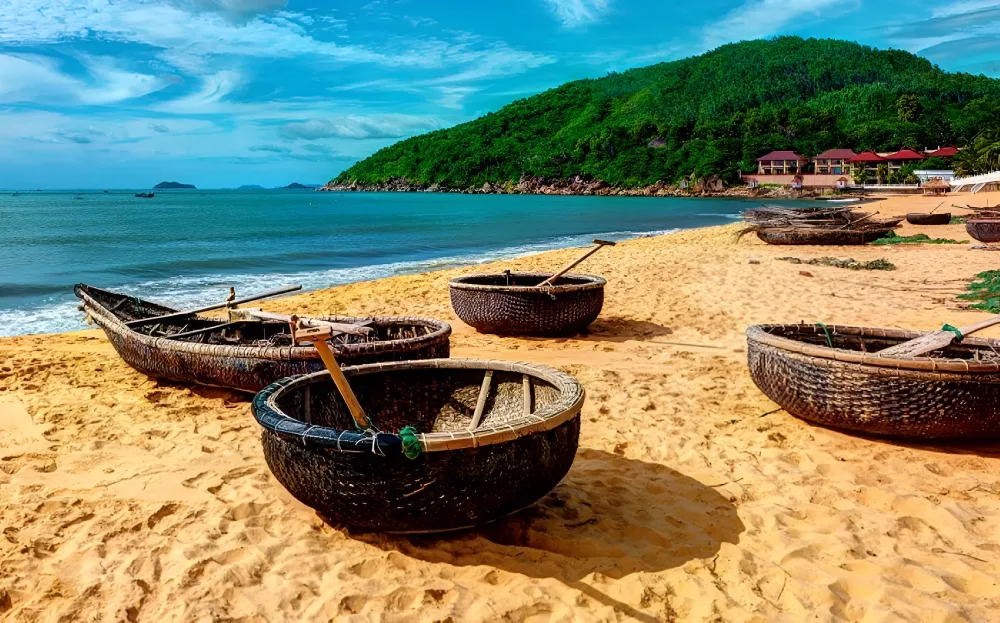
Quy Nhon may not appear on every Vietnam itinerary, but for those who make the journey, it offers a rare combination of unspoiled beaches, rich history, delicious food, and genuine local hospitality. For first-time visitors, this guide highlights the best things to do in Quy Nhon Vietnam, activities and experiences that showcase the city’s charm beyond its coastline. If you’re ready to explore Quy Nhon and broader Vietnam at your own pace, consider planning with a local operator like IZITOUR, who can help you customize a journey and uncover hidden corners that most travelers miss.
Discover Vietnam Holidays w/ Beach Break
See more:
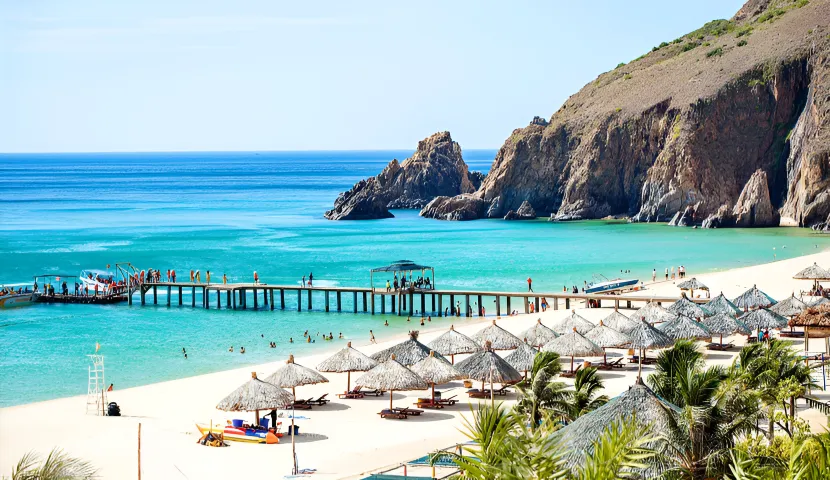







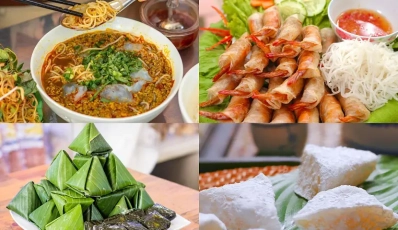
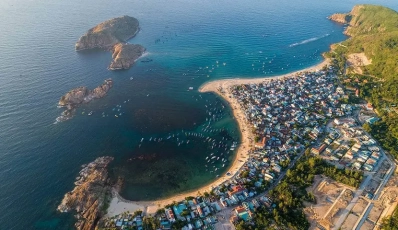
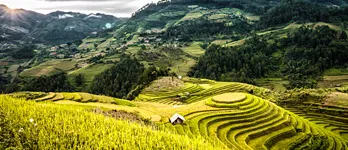
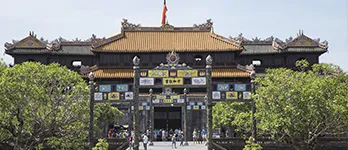
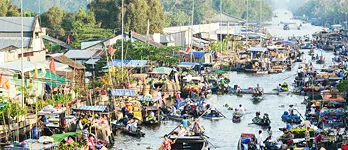

 TRAVELERS' CHOICE 2025
TRAVELERS' CHOICE 2025 